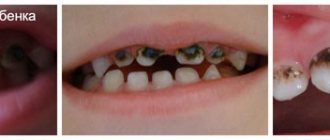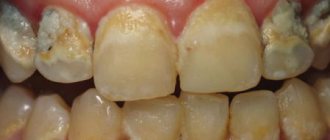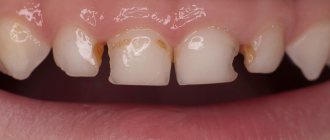From this article you will learn:
- how to silver teeth - photo,
- indications and contraindications for the procedure,
- preparations for silvering teeth in children.
The article was written by a practicing dentist.
Silvering of teeth is a conservative method of treating caries of primary teeth in children, which consists of impregnating the caries-affected areas of the tooth with silver. This method is most often used in children aged 2-3 years, or in children over 3 years old - with a strong fear of the dentist. The method has its drawbacks, and is not indicated for every child, but in some cases it is the only way to do without removing teeth before their physiological change.
In dentistry, the following drugs are usually used to silver baby teeth in children: Saforide or two-component Argenate. The effectiveness of silver plating will largely depend on the stage of the carious process. The method will be especially effective in the initial form of caries in the white spot stage, as well as superficial caries (i.e. in cases where the carious process does not extend beyond the enamel layer). With average caries, when dentin is already damaged, the method has very limited effectiveness.
Teeth after silvering: photo
Silvering of teeth in children can be performed from the moment they erupt (from 6 months), the procedure does not require anesthesia and is well tolerated even by emotionally unbalanced children. The visible disadvantage of the method is the change in the color of the teeth - which must be warned in advance to the child’s parents, having obtained their consent to use the method. In this case, only demineralized areas of tooth enamel affected by caries change their color (the color of healthy enamel does not change).
What is silvering of teeth
Silvering is an old technique that is still used in some dentistry in an attempt to protect baby teeth affected by caries. To do this, the doctor simply covers the infected area of enamel with silver.
Today, the very idea of clogging dangerous microorganisms in tooth tissue under a layer of metal seems strange, but some doctors are still convinced that such a method of combating caries has a place. Why? Because silver has antimicrobial properties.
Indeed, such a film can prevent the development of caries, but only if it is at a very early stage, when the enamel has become loose and bacteria have just begun to colonize its cells. Finding caries in a child at this stage is an almost impossible task, and in other cases, silvering will not only not bring the promised result, but can even cause harm to the teeth.
Silvering of teeth can only be effective when caries is in the white spot stage. Then an antimicrobial film created from metal can really protect tooth tissue from further penetration of microorganisms and destruction of enamel tissue.
Indications and contraindications
Silver treatment of baby teeth is indicated for children in several cases:
- thinning of tooth enamel and the presence of small defects - chips, microcracks;
- in the presence of carious formations in the white spot stage;
- to prevent the development of infection and proliferation of pathogens;
- to extend the service life of the filling;
- with increased sensitivity of the gums to temperature changes.
Silvering of teeth is performed on children to prevent recurrence of caries, however, if the damage has spread not only to tooth enamel, but also to dentin, then the procedure is strictly contraindicated.
Important! Dentin is a layer of tissue located under the tooth enamel. In children, dentin has a soft and loose structure, so caries spreads very quickly in it. If the lesion has progressed to the stage of medium caries, then treatment with silver should be carried out monthly, however, there is no absolute guarantee that the superficial destruction of dental tissues will not develop into pulpitis.
It is also unacceptable to silver tooth enamel if:
- components of preparations for coating enamel cause an allergic reaction in the baby;
- the young patient suffers from severe somatic pathologies;
- the baby has developed deep caries;
- patient over 3 years old.
Important! Doctors never recommend silvering the teeth of children who eat foods high in fluoride.
Why is it important to save every baby tooth?
- To protect permanent teeth.
Advanced caries can not only lead to the destruction of milk teeth, but also damage the rudiments of permanent ones. - To form the correct bite.
Early removal of baby teeth will lead to displacement of the dentition, and the permanent bite will be incorrect. - For the health of body systems.
Long-term absence of teeth can lead to disruption of the digestive system, as the child will not be able to chew food well.
Types of dental crowns for chewing teeth
When choosing a material for creating a microprosthesis, you should take into account the functional purpose of the teeth. The molars of the posterior zone of the dentofacial apparatus are subjected to strong mechanical and chemical stress when chewing food.
Eating food that differs in taste, composition and hardness can quickly damage the nozzle, which is made of aesthetic material, but vulnerable to the abrasive properties of some products. In addition, the material should not cause allergies to the soft tissues of the oral cavity.
Therefore, it is better to entrust the choice of material for making crowns to a specialist.
How does silvering of teeth occur?
Silver plating is done only on baby teeth. This is an absolutely painless procedure, it takes from 10 minutes to half an hour - it all depends on how many teeth need to be covered.
First, the dentist examines the baby’s oral cavity, then removes plaque from the surface of the infected tooth and applies a composition to the enamel. In fact, for silvering it is not pure silver that is used, but a special solution - silver nitrate. It enters into a chemical reaction and blocks the dentinal tubules, preventing bacteria from accessing them.
Over time, the film deteriorates, so it is recommended to repeat the procedure regularly - at least once every 6 months.
After teeth silvering, their color becomes dark and the smile becomes unaesthetic. That is why this method of combating early-stage caries is not used when it comes to permanent teeth.
Prices for partial dentures
The absence of several units in the dentition can be compensated for by removable dentures , among which the most famous are the following:
Acrylic, nylon and polypropylene plate prostheses. They have approximately the same quality, but acrylic is harder. Not the most comfortable and reliable designs, but their prices suit many patients - a prosthesis for one jaw costs from 14 thousand rubles. If you need to replace a small number of teeth, the price may be slightly lower.- Clasp dentures. Higher quality structures that are fixed in different ways in the oral cavity, which leads to a wide variety of prices - from approximately 20 to 90 thousand rubles.
- Immediate dentures. If one or two front or back teeth are temporarily missing, the dentist can install a butterfly denture. It is short-lived, but lasts long enough to last until a permanent dental implant is inserted. The cost is varied: cheap ones - from 3 thousand rubles, higher quality ones - from 12 thousand rubles.
Clasp dentures are an expensive pleasure, especially if you choose the highest quality materials and fasteners. With sufficient financial resources and in the absence of contraindications, preference is often given to this method of prosthetics.
To silver teeth or not?
Silvering is a painless procedure, but its effect may not only not meet your expectations, but also negatively affect the child’s attitude towards dental treatment.
Firstly, before the procedure, the doctor needs to thoroughly clean the baby’s teeth, and this can frighten him. Secondly, the black color of the enamel will cause psychological discomfort to the baby - he will begin to feel embarrassed about his smile.
In addition, silvering of a tooth with moderate or deep caries can be dangerous. Bacteria remain sealed in the dentinal tubules and actively multiply there, while the enamel darkened due to silver nitrate does not even give parents a chance to notice this process. As a result, caries develops into pulpitis within a few months, and a tooth that could be saved has to be removed.
In addition, during the procedure, the composition may get on the gums. Itching, redness or burns occur in this area, and even an allergic reaction is possible.
Silvering of teeth does not cure, it can only stop the development of caries, but only when it comes to damage to the upper layer of enamel.
A feature of early childhood caries is its very rapid progression, which often leads to tooth loss. Some parents do not consider this a serious problem, since temporary teeth should fall out soon anyway. But premature loss of primary occlusion elements can cause orthodontic problems in adults. Therefore, it is extremely important to stop the development of the disease as early as possible.
If you have time to silver the milk teeth at the white spot stage, you can avoid the spread of the process deep into the tissues and preserve them until the time of natural replacement.
What is silver dental treatment?
The method of silvering children's teeth is not new in dentistry. For decades, doctors have been using this procedure to treat young children.
Silver plating is not an entirely accurate term. For treatment, not pure noble metal is used, but its active salts. The composition of the medicinal product includes silver fluoride diamine. When it interacts with the inorganic component of the enamel, microscopic crystals of silver phosphate and calcium fluoride are formed, which seal the dentinal tubules and prevent the entry of pathogenic microorganisms. At the same time, silver ions suppress microbial activity.
The tooth surface treated in this way becomes much denser and more resistant to the action of acids that enter with food or are released by bacteria in the course of their life.
Today, the most common drugs for silvering teeth in children are the Japanese “Saforaid” and the Russian “Argenat”. They have a comprehensive therapeutic and preventive effect on tooth enamel and are absolutely safe for the child’s health.
How are baby teeth silvered?
The silvering technique is simple and does not take much time. The tooth surface affected by caries is thoroughly cleaned of plaque and the medicinal preparation is carefully applied with a cotton applicator. That's all. This procedure does not cause any discomfort or negative reaction in the child.
How many times it is necessary to repeat the silvering process is decided individually in each case. Usually 3-5 procedures are enough, which are performed daily or every other day. Such courses are repeated every 4-6 months.
Indications and contraindications for the procedure
Like any other medical procedure, silvering of teeth has its own indications and contraindications for use.
This technique is indicated only if caries is detected at the spot stage in a child under 3 years of age.
Silvering has the following contraindications:
- Damage to caries.
- The child has severe somatic diseases.
- The child has allergic reactions to the constituent components of medicinal drugs.
- Age over 3 years, when it is possible to use other methods.
Advantages and disadvantages of the technique
To date, the opinions of pediatric dentists regarding the procedure for coating children’s teeth with silver are ambiguous. There are many supporters of this technique, since it has proven its effectiveness for decades. Among them is the famous doctor Komarovsky, who does not exclude silvering as an option for treating the initial manifestations of caries. But there are also its opponents, who point out a number of negative aspects.
Advantages of the procedure:
- the ability to stop the development of the carious process;
- absence of negative reaction from the little patient;
- Silver plating is not contraindicated in young children;
- relatively low cost and accessible to everyone.
Disadvantages of silvering teeth:
- the formation of black plaque on the tooth surface, which looks very unaesthetic;
- it is impossible to apply the technique with .
It is precisely because of such negative consequences that it is not recommended to silver-plate the front baby teeth in school-age children, since this can cause psychological discomfort in the child and ridicule of classmates.
Is it possible to silver teeth at home?
The procedure for plating baby teeth with silver is simple and only takes a few minutes. So maybe it’s worth doing it at home, especially when the child is afraid to even go into the dentist’s office?
The answer to this question is a categorical no! It is impossible to carry out such a manipulation, although simple, outside a medical institution, since preparations based on silver fluoride diamine are absolutely safe, but they can still cause an uncontrollable allergic reaction in the child.
Without special knowledge and tools, parents cannot independently determine the depth of the lesion. And if dentin is damaged, the procedure will not only have no beneficial effect, but will also provoke the death of the pulp.
In addition, insufficiently thorough cleaning of the tooth surface will lead to plaque turning black, which will be almost impossible to remove.
Alternative to silver plating
Dentistry does not stand still. Outdated methods are being replaced by new technologies that make it even easier to keep children healthy.
If there are contraindications to silvering of teeth in a child and if the parents wish not to spoil the appearance of the smile, a number of other methods can be used:
- Fluoridation or treatment of enamel with active fluorine-containing preparations that form a dense mineral film on its surface and protect it from the action of pathogenic microorganisms. This technique can be used only after 3-4 years.
- Ozonation is the treatment of teeth with ozone, which has a strong antimicrobial effect. After the death of microorganisms, the processes of tissue destruction are suspended, caries does not progress.
You can give your preference to silvering or fluoridation, and perhaps ozonation, only after weighing all the pros and cons. Each method has its own pros and cons that need to be taken into account.
Which is better: fluoridation or silvering of teeth?
Fluoridation is an alternative to silvering teeth. This is a gentle procedure that strengthens the enamel, making it denser and more reliable. Thanks to this, acids - the main cause of caries - will not be able to damage the strengthened surface of the tooth.
At the same time, fluoridation, like silvering, does not treat teeth and does not relieve them of caries, but it helps prevent infection from penetrating the enamel tissue. In addition, this procedure has a positive effect on its shade - it makes it lighter.
Budget and most expensive dentures
The cost of prosthetics in various clinics can range from 4,000–5,000 rubles. up to 250,000 – 300,000 rub. The cheapest crowns are made of plastic and base metals. Metal-ceramic prostheses are also considered more expensive, costing an average of 12,000 rubles. Designs made from solid ceramics and zirconium dioxide are even more expensive - the price range can range from 19,000 to 35,000 rubles.
The most inexpensive way to restore complete edentia is to install removable acrylic structures. The most expensive option is prosthetics on implants, with the fixation of several bridges or a one-piece complete denture.
What to do to avoid silver teeth
- Visit your pediatric dentist regularly for checkups and learn how to properly and thoroughly brush your teeth.
- Help brush your child's teeth until you are sure that the baby can now handle this task well on his own.
- Regularly undergo professional oral and dental hygiene. Depending on the age of the child, the set of procedures differs, but its main task is to remove all plaque and tartar.
- Carry out fluoridation and remotherapy to strengthen the enamel and protect it from bacteria and acids.
- Seal the fissures of the chewing teeth. This is a safe and painless procedure that will reliably protect against caries.
To silver teeth or not, each parent decides for himself. But when choosing this procedure, it is important to understand that it will not protect the baby’s baby teeth from caries and will not cure them, but on the contrary, it can cause early tooth extraction and the appearance of complexes in the child. Today there are alternative methods of silvering. They are safe, effective and really help prevent the occurrence of caries and its complications. Doctors at the Center for Modern Dentistry clinic daily and successfully use these methods to strengthen and protect your teeth.
Reasons for the development of early childhood caries -
As we said above, any means of treating caries will not be very effective if parents are not ready to implement or control the quality of oral hygiene in the child. It will also not be possible to achieve a positive result if you allow your child to eat between main meals - sweets, flour, starchy foods, drink sweet soda, or sweet or sour juices. Thus, without following a diet and controlling the consumption of easily digestible carbohydrates, the effect of treatment will tend to zero.
Our website has professional reviews on oral hygiene in children that will help you avoid the risk of developing caries in your child altogether. You can write your questions in the comments to this article. And we hope that our article: Silvering teeth for children reviews - was useful to you!
Sources:
1. The author’s higher professional education in dentistry, 2. Based on 20 years of personal experience as a dentist, 3. The European Academy of Paediatric Dentistry (EU), 4. National Library of Medicine (USA), 5. “Pediatric therapeutic dentistry. National leadership" (Leontyev V.K.).
The cost of restoring teeth with inlays and veneers
If the tooth is not completely destroyed, but the filling cannot restore its appearance and function, you can make an inlay from metal or ceramic.
| Type of tab | How much does it cost to insert an inlay into one tooth (thousand rubles) |
| Made from pressed porcelain mass | From 11 |
| Cobalt-chromium | From 3.5 |
| From zirconium dioxide | From 14 |
| Golden | Depends on current gold prices and the weight of the tab |
Small defects can be corrected with the help of overlays on the front tooth surface - veneers. Such plates are suitable for improving the appearance of the front teeth, as they are not too durable, but very aesthetic.
Ordinary veneers cost from 20 thousand rubles. While their improved, thinner and more beautiful analogues - lumineers - can cost twice as much. If the pads deteriorate, they are not replaced. In this case, there is only one thing you can do - install a crown.
Dental tab
Veneer
SILVER PLATING AT HOME
Many parents are interested in whether it is possible to silver teeth themselves? Dentists prohibit doing this, since without medical education it is impossible to carry out silvering correctly using dental preparations.
Silver plating can cause harm instead of benefit if it is applied to a tooth with deep carious lesions. It is impossible to independently determine the degree of tissue damage. Therefore, experimenting with treatment is strictly prohibited.
Another point is to clean the enamel from plaque. Parents will not be able to properly clean the surface of their teeth from plaque, so coating with a silver film “solders” the plaque to the enamel. After this, it will be difficult to clean the enamel from such a layer.
What are the negative sides
The silvering procedure becomes useless when caries reaches the stage of cavity formation and affects dentin - the layer of dental tissue that is located directly under the enamel. This part of the tooth in childhood is soft and friable, so pathology “captures” healthy tissue incredibly quickly. When caries moves to the middle stage, doctors advise undergoing silvering almost monthly, but even in this state of affairs, no one will give you a guarantee that the disease will not soon develop into pulpitis.
When discussing the benefits and harms of this procedure, one cannot help but note the risk that the pulp may be burned by chemicals. As experts in the field of pediatric dentistry explain, silvering in damaged dentin and the presence of medium-depth cavities can provoke a burn of the pulp and contribute to the occurrence of pulpitis. The chemical component of the drug can easily leak into the nerve if only a thin layer of dental tissue remains between it and the wall of the carious cavity. Therefore, it is very important that the doctor is able to accurately determine how safe the procedure will be at this stage of the development of the pathology.
The most well-known disadvantage of this method is the fact that after silvering, teeth become dark and lose their aesthetic appearance. Take a look at the photos before and after the procedure - the difference is obvious. The way a smile looks afterwards often repels parents, and it is not surprising, because the child may subsequently develop serious complexes.
Photos before and after the procedure
When cheap domestically produced materials are used for silvering, the enamel turns black. Teeth are subject to less discoloration if higher quality preparations are used, for example, Saforide or Argenate. In this case, the treated areas will acquire a grayish tint.
On a note! You may have probably heard about colorless silvering, but this does not mean that after the procedure the teeth will not change their color. It is called colorless only because after treatment not all the enamel darkens, but only the treated areas. In this case, healthy tissues are not stained.
PSYCHOLOGICAL PROBLEM
Some children may react negatively to changes in enamel color after silvering. Therefore, it is important to have a preliminary conversation and explain to the baby that dark teeth are better than sick ones. If you clearly tell your child that after plating you won’t have to drill your teeth with a drill, he will be able to understand the importance of silvering.
You can convince the baby that now he will not have black teeth, but silver - precious ones. Many children manage to overcome the ridicule of their peers and become confident in the correctness of their choice. After this, the situation changes, and peers stop pointing fingers at black teeth.
CARRYING OUT THE PROCEDURE
First, the dentist cleans the surface of the tooth so that no foreign particles from food remain on it. Then apply the mixture with a cotton swab and leave until hardened. They don't do anything else.
What is the coating solution made of? It contains silver nitrate - 30%. In dental practice, fluoride compounds can be added to silver nitrate, which have a strengthening effect on the enamel.
Note! The method of silvering baby teeth will need to be repeated several times. The dentist will notify you about this.
How many times does silvering need to be done? Sometimes this is done every three months, sometimes the baby needs to repeat the procedure every six months. What determines the frequency of the procedure? This is due to the type of feeding (breastfeeding or formula feeding) and the structure of the enamel of the molars. Thin enamel requires more careful care than durable enamel.
When is re-silvering required? The film wears off over time due to chewing of food. The silver film reacts to acids from food, so the child must be shown to the dentist regularly.
ARGENATE AND SAPHORITE
Modern dentistry suggests using drugs such as Argenate and Saforite containing silver fluoride diamine.
Argenate can be one-component or two-component. One-component is used to strengthen enamel and clog dentin tubules. The two-component drug has a similar effect for a longer period. It is used in the treatment of cervical caries, since the petroleum jelly contained in the composition protects the mucous membrane from burns by silver ions. After using Argenate, a dark film forms on the teeth, just like after silvering.
The drug Saforide is an analogue of Argenate of Japanese origin, therefore it costs many times more. In terms of the quality of the effect, it does not differ from Argenate. After imported drugs, teeth darken in the same way and are not cleaned with toothpastes.
What determines the cost of prosthetics?
Prices for installing dentures and artificial crowns depend not only on the cost of the structures, but also on the following indicators:
- Type of medical institution – public or private.
- The level of material equipment in dentistry and the availability of experienced, highly qualified personnel.
- The type of material used to make an implant or crown.
- Manufacturer of the product or material for its manufacture - domestic or foreign.
- Additional costs due to the need for preliminary treatment of oral diseases.
- The cost of the dentist and dental technician to prepare, manufacture and install a crown, implant or bridge.
Prices for crowns, implants, bridges and other types of prostheses can vary greatly in different clinics. You can only find out how much it costs to insert one tooth from your attending physician. Since the websites of dental clinics most often indicate price ranges or their minimum values.











